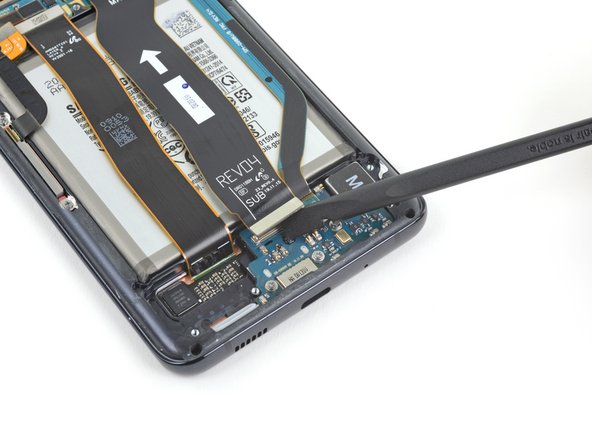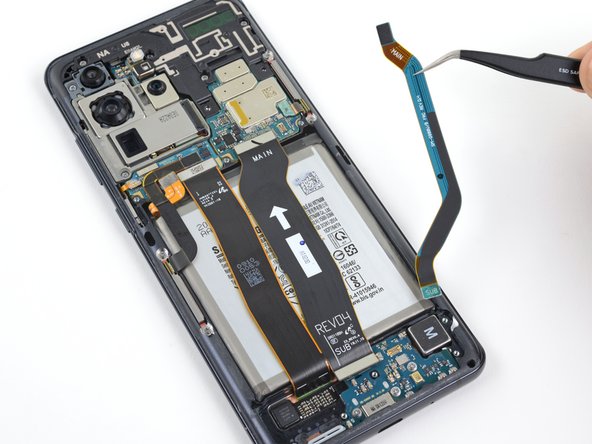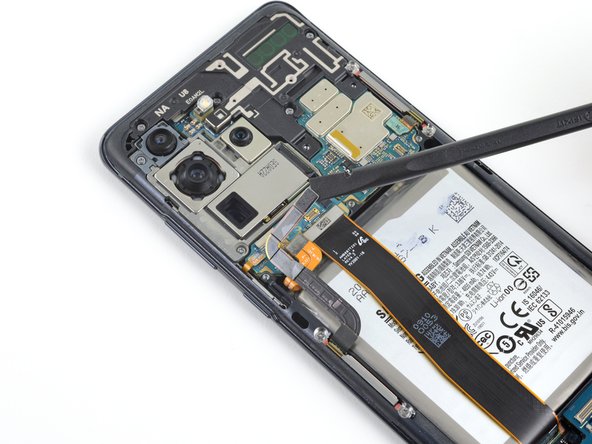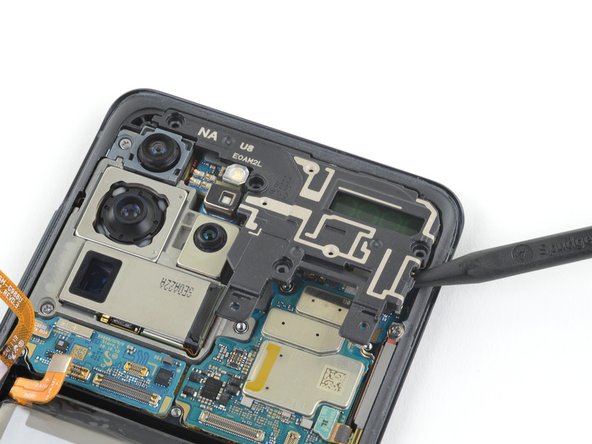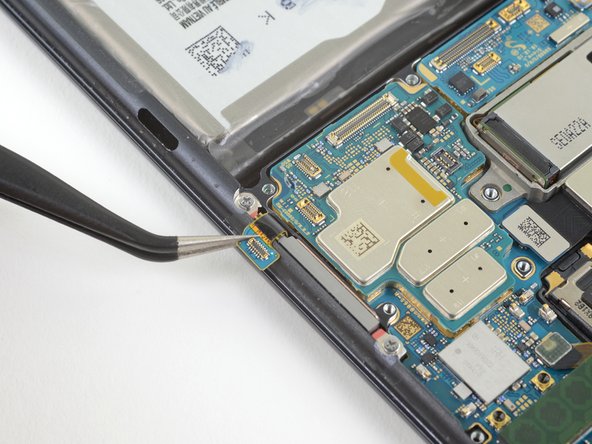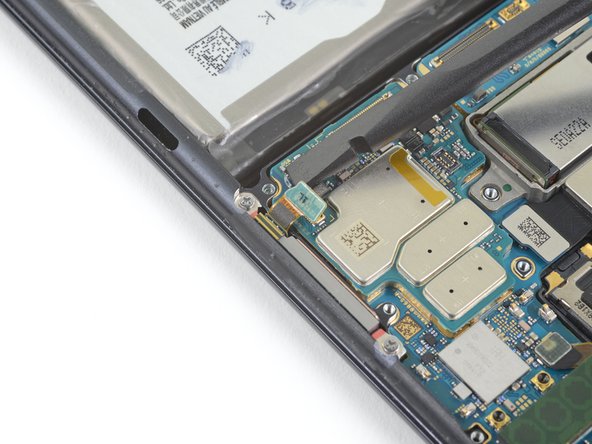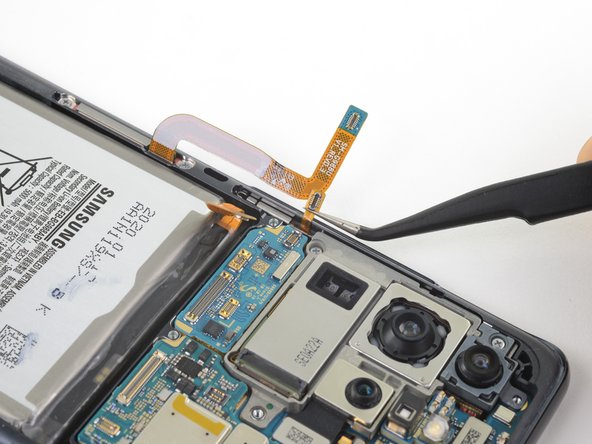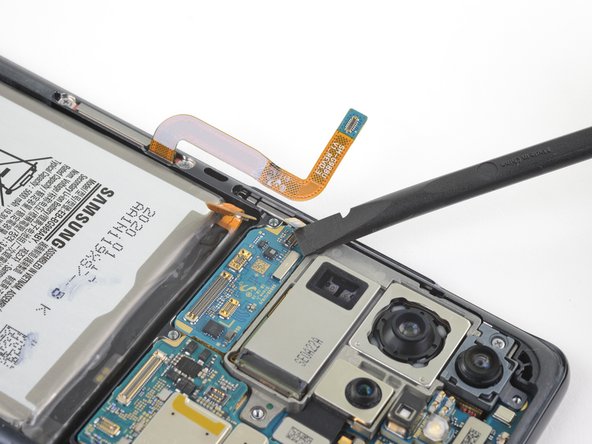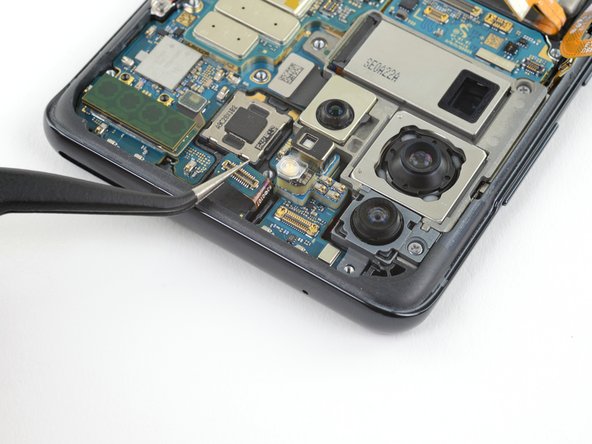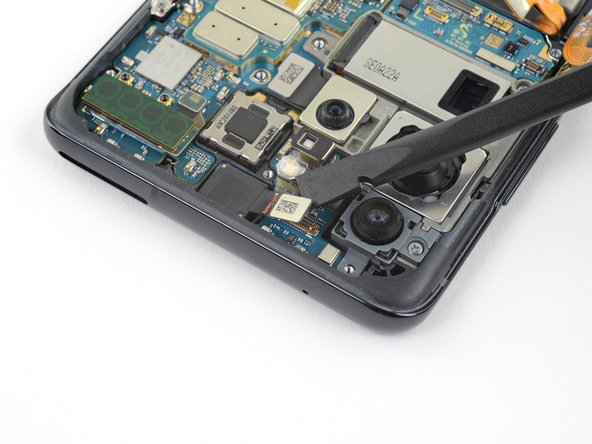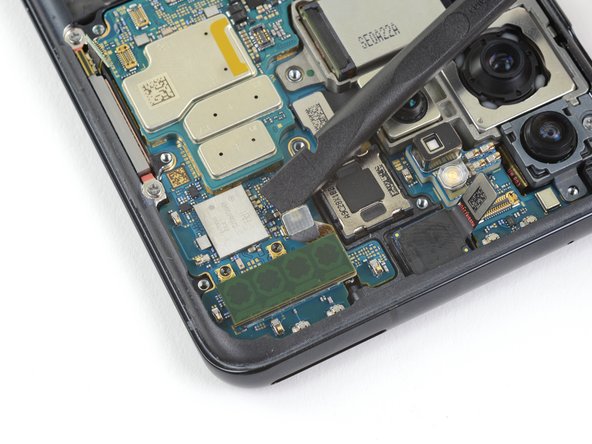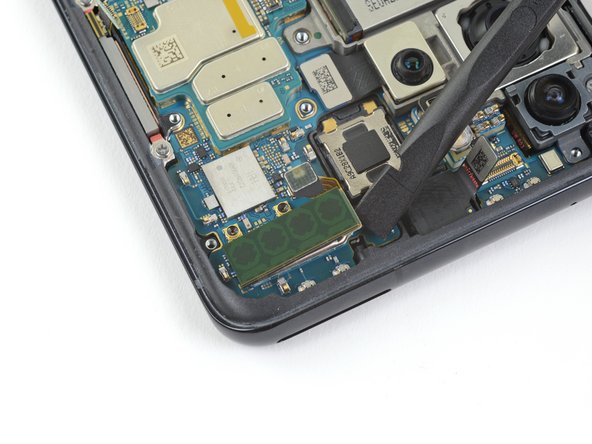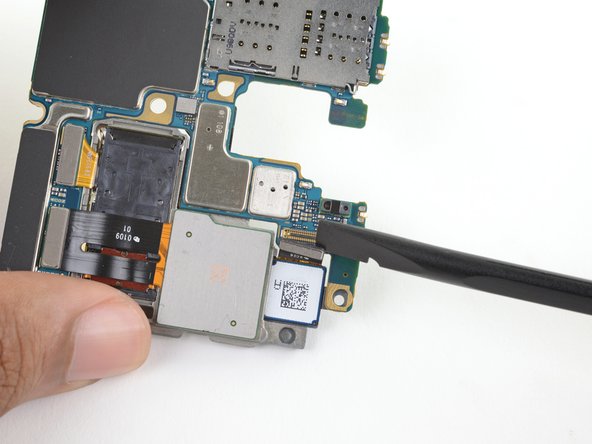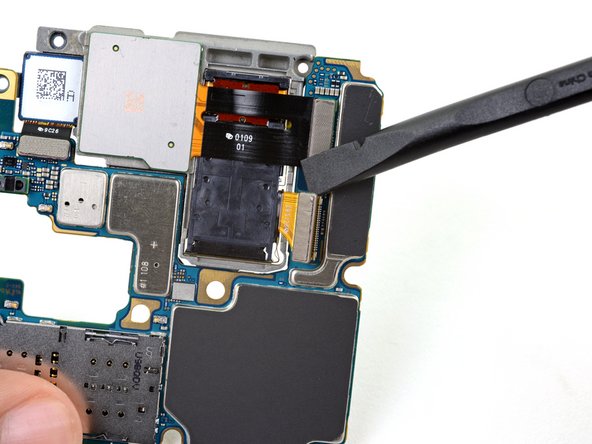Samsung Galaxy S20 Ultra Motherboard Replacement
Duration: 45 minutes
Steps: 44 Steps
Time to get that Galaxy S20 Ultra back in shape! Follow these steps to swap out the motherboard and breathe new life into your device. Just make sure you've got some replacement adhesive on hand to wrap up the repair.
Step 1
No need to stress if you popped that tool into the other hole—rest assured, the microphone and the ingress gasket are safely tucked away from any danger.
- Grab your SIM eject tool, a tiny bit, or even a trusty straightened paperclip—whatever you’ve got on hand works!
- Give it a confident poke into the little hole on the SIM tray (you’ll find it at the top edge of your phone, hanging out next to the plastic antenna band).
- Push in with a bit of oomph, and voilà—the tray pops out!
Tools Used
Step 2
The SIM card tray tends to be pretty loose, so the card might slide right out. Keep an eye on it during handling to avoid any accidental drops or lost data.
- Pop out the SIM card tray like a pro.
- When sliding the SIM card back in, make sure it matches up with the tray—no upside-down acrobatics needed.
- Spot a thin rubber gasket around the SIM tray? That’s your phone’s water and dust bouncer. If it’s torn or missing, swap out the gasket or tray to keep your phone safe and sound.
Step 3
First things first, make sure to unplug and power down your phone before diving in. Safety first, right?
If you're feeling a bit adventurous, you can use a hair dryer, heat gun, or hot plate to warm things up. Just keep an eye on the heat—both the display and the internal battery can be a bit sensitive to overheating. Let's keep them happy!
- Warm up your iOpener and set it on the bottom edge of the back cover for about two minutes. Let it work its magic to soften up the adhesive.
Tools Used
Step 4
Handle with care—don't go all Hulk on the pick, or you might crack that back cover glass. Gentle nudges are the way to go!
If your back cover is looking a bit worse for wear with some serious cracks, a layer of clear packing tape might just do the trick to help the suction cup stick. If you're feeling adventurous, you can also try using some super strong tape instead of the suction cup. And if you're really in a bind, a little superglue on the suction cup can help it cling to the broken cover.
Getting that cover off can be a bit of a dance, so don't be surprised if you need to reheat with the iOpener and give it another go with the suction cup a few times before it cooperates.
If you're struggling to create a gap, just add a bit more heat to the edge and give it another shot. You've got this!
- Grab a suction cup and stick it onto the back of your phone, aiming for that sweet spot near the middle of the bottom edge.
- Give that suction cup a solid pull! You want to make a nice little gap between the back cover and the phone frame.
- Slide the tip of an opening pick into that newly formed gap and get ready to work your magic.
Tools Used
Step 5
Watch out for those phone corners—the glass is curved there, and trying to cut the adhesive can lead to a crack party you definitely don’t want.
- Glide the pick back and forth along the bottom edge to slice through that stubborn adhesive—it’s like convincing gum to let go of your shoe.
- Leave the pick chilling in the seam to keep the adhesive from making a comeback.
Step 6
- Give the left edge of the back cover a spa day with a heated iOpener for about two minutes—let that warmth work its magic.
Tools Used
Step 7
Handle the pick gently—don't go all Hulk on it or you might crack that back cover glass. Keep it cool, and if you need a hand, you can always schedule a repair.
This might take a few tries because of those super tight tolerances, but don’t sweat it, just keep going!
Since the glass is curved along the edge, the pick won't go in too far. No worries, as long as the tip is just under the edge of the glass, you’re good to move forward.
If you're struggling to create a gap, try heating up the edge a little more and give it another shot.
- Start by sticking a suction cup onto the back of the phone, near the left edge and as close to the center as possible. Then, gently pull on the suction cup with steady, firm pressure to create a small gap between the back cover and the frame. Next, slide an opening pick into the gap to help loosen the adhesive. For an extra boost, try applying a few drops of high-concentration (over 90%) isopropyl alcohol into the seam—this can help dissolve the glue and make the process smoother. If you need assistance, you can always schedule a repair.
Step 8
- Gently slide the pick under the edge of the glass, then give it a little tilt and push it along to fully free the back cover from its sticky grip.
Step 9
- Gently slide your pick along the bottom edge of the phone to break the back cover's adhesive seal.
- Leave the pick resting under the left side of the glass, near the bottom, to stop the adhesive from sticking back together.
Step 10
Watch out when sliding near the ridge around the volume and power buttons—since the glass cutout can be a bit fragile, it might crack more easily. Take it slow and steady, and if you need a hand, you can always schedule a repair.
- Slip a pick right under the middle of the left edge of the back cover to get started.
- Slowly work your pick upward along the device to loosen the adhesive holding the back on.
- Keep your pick tucked under the top-left corner of the glass near the top of the device so the adhesive doesn’t stick back together. If you need a hand, you can always schedule a repair.
Step 11
A hair dryer, heat gun, or hot plate can do the trick, but watch out—you don’t want to turn your phone into a toaster. Keep the heat gentle to avoid damaging the display or internal battery. If you're unsure, it’s always a good idea to schedule a repair for professional help.
- Place a heated iOpener on the right edge of the back cover and hold it there for about two minutes. This helps loosen things up, making your next steps smoother. If you need a hand, you can always schedule a repair.
Tools Used
Step 12
Just like before, tilt that opening pick down and slide it all the way under the back cover. You’ve got this!
- Stick a suction cup on the back of your phone, aiming for the center near the right edge—think of it as the phone’s sweet spot.
- Give that suction cup a firm, steady pull to coax a gap open between the back cover and the frame. Slow and steady wins the race here.
- Slide the tip of an opening pick into the gap you just made. Like sneaking a chip into a bag, but with more purpose.
Step 13
- Gently slide your pick down towards the bottom edge of the phone to break the seal of the back cover's adhesive. You've got this!
- Once you're in, tuck your pick under the right edge of the glass near the bottom. This will keep that pesky adhesive from sticking back together while you work your magic!
Step 14
As you're working, you might notice the bottom edge of the back cover lets go of those three picks hanging out down there. No problem—just set those picks aside, since the bottom edge won’t be sticking back together from here on out.
- Slide another pick under the center of the right edge of the back cover. You're halfway there!
- Carefully move the pick upwards along the edge of the device to gently break the seal of the adhesive. Easy peasy!
Step 15
- Warm up the top edge of the back cover by pressing a heated iOpener against it for two minutes. This helps loosen the adhesive so the cover can come off more easily.
Tools Used
Step 16
The glass near the corners of the back cover curves a bit and can be more prone to cracking. Handle with care during this step to avoid any unwanted damage to your back cover.
If slicing gets tricky, pause for a moment and give it another round of heat before you keep going.
- Gently slide your pick from the right edge of the device, moving around the top right corner. Keep going along the top edge until you’ve fully separated the back cover adhesive. If you need help, you can always schedule a repair.
Step 17
- Gently lift the back cover. If there’s any stubborn adhesive hanging around, use an opening pick to slice through it with ease.
- Carefully remove the back cover and set it aside.
- Pro tip: Before you start reassembling, power up your device and make sure everything is working smoothly. You’ll thank yourself later!
- If you’re dealing with some leftover adhesive, grab some tweezers (or your fingers) to clear it out. Need extra help? A little heat should do the trick to loosen it up.
- Using Samsung custom-cut adhesives? No worries, just follow the guide here for a smooth process.
- Got double-sided tape on hand? Follow this guide for detailed steps and you’ll be good to go.
Tools Used
Step 18
When you're unplugging those connectors, just remember to keep an eye on those tiny surface-mounted components hanging out nearby. We don’t want them to go for a wild ride!
- Grab your trusty spudger and pop up the wireless charging coil connector—just a gentle nudge will do the trick.
Tools Used
Step 19
- Grab a trusty pair of tweezers and carefully lift the wireless charging coil away from the device. Take your time, it's like a delicate dance!
- Now, go ahead and remove that wireless charging coil. You've got this!
- When it's time to put everything back together, start by reconnecting the wireless charging coil connector first. This will help you get it all lined up just right. Then, give the rest of the coil a good press down to make sure it sticks. You're almost there!
Tools Used
Step 20
As you dive into this repair, keep tabs on each screw—putting them back in their original spots will save you a world of headaches later.
- Grab your Phillips #00 screwdriver and take out the five screws (they're 3.9 mm long) that are holding the motherboard bracket in place.
Tools Used
Step 21
- Grab those tweezers and gently unclip the motherboard bracket to free it up. Easy does it—no force needed. If you hit a snag, remember you can always schedule a repair for extra help.
Tools Used
Step 22
- Grab your trusty spudger and gently lift up the battery connector to disconnect it.
Tools Used
Step 23
- Grab your trusty Phillips #00 screwdriver and tackle those five 3.9 mm-long screws that are holding the loudspeaker and lower midframe in place. You've got this!
Tools Used
Step 24
- Take your spudger or tweezers and pop them into the top left notch of the midframe—give it a gentle pry to unclip those sneaky fasteners holding everything together.
- Lift out the loudspeaker and the lower midframe like you’re revealing the secret sauce behind your device’s coolness.
Step 25
- Grab a spudger and gently pry up the main and auxiliary flex cables from the daughterboard near the bottom of your device. When it’s time to reconnect those press connectors, line them up carefully and press down on one side until it clicks, then do the same on the other. Avoid pressing on the middle to prevent bending the pins—bending is bad news. Need a hand? You can always schedule a repair if things get tricky.
Tools Used
Step 26
- Gently pop up those main and auxiliary flex cables from the motherboard using your trusty spudger. One smooth move and they're free!
Tools Used
Step 27
- Carefully lift and slide out the main and auxiliary flex cables—like you’re removing spaghetti from a bowl, but way less messy.
Step 28
- Gently pop up the left 5G antenna cable and unplug it from the motherboard—easy does it!
Step 29
- Gently lift up and unplug the main display flex cable from the motherboard. Easy does it, but make sure it’s fully disconnected before moving on.
Step 30
- Carefully lift and flex the display and left 5G antenna cables aside, making sure they don’t block access to the motherboard or battery.
Step 31
- Grab a Phillips #00 screwdriver and unscrew the four 3.9 mm screws holding down the upper midframe. Easy does it!
Tools Used
Step 32
- Grab your trusty spudger and pop it into the notch on the right side of the upper midframe. Give it a gentle twist to unclip those stubborn clips.
- Lift off the upper midframe and set it aside like a pro.
Tools Used
Step 33
- Gently lift and disconnect the right 5G antenna flex cable from the motherboard—think of it as unplugging a little spaghetti noodle.
- Grab your trusty tweezers and nudge that cable out of the motherboard’s way, like you’re clearing a dance floor for the next move.
Tools Used
Step 34
- Gently pry up the side button flex cable to unplug it from the motherboard. No wrestling moves needed.
- Swing the cable out of the way so the motherboard has some breathing room.
Step 35
- Gently pop up the front-facing camera flex cable from the motherboard—like opening a stubborn jar, but with way less mess.
- Swing that cable away from the motherboard so it’s not photobombing your next repair move.
Step 36
- Gently pop up and unplug the upper 5G antenna cable from the motherboard.
Step 37
There's a little adhesive holding the module in place, but it should pop out without much fuss.
- Grab your trusty spudger and gently coax up the corner of the 5G millimeter wave antenna module. It’s like a little surprise waiting to be uncovered!
- Time to say goodbye to the 5G antenna module. It served you well!
- When you're putting everything back together, make sure to connect that 5G antenna first. It’s like getting the first piece of a puzzle just right! Then, give the rest of the antenna module a solid press to make sure it’s snug and secure. You’ve got this!
Tools Used
Step 38
- Grab a Phillips #00 screwdriver and carefully remove the pair of 3.9 mm screws holding down the motherboard and camera assembly. Easy does it—you're well on your way to the next step. If you need help, you can always schedule a repair.
Tools Used
Step 39
- Slide the tip of your spudger into the bottom left corner of the motherboard assembly and gently lever it up—think of it like popping open a stubborn jar, but cooler.
- Lift out the motherboard assembly. Go slow and steady, and let gravity help you out.
Tools Used
Step 40
- Gently lift and disconnect the ultrawide camera connector from the motherboard. Keep things careful and friendly—you're doing great! If you need a hand, remember you can always schedule a repair.
Step 41
- Gently lift and unplug the telephoto and wide-angle camera connectors from the motherboard with a dash of finesse.
Step 42
- Flip the motherboard assembly over, then gently pop up and disconnect the depth sensor connector from the motherboard.
Step 43
When swapping out individual cameras, you might need to carefully separate and move some of the old cameras over to your new module. Take your time and handle everything with care—it’ll pay off!
- Gently lift out the rear camera module—like you're removing a jewel from a crown.
Step 44
- Double-check your new part next to the original—sometimes there’s a little leftover adhesive or a sneaky component that needs transferring.
- Ready to put it all back together? Just reverse the steps and watch your device come back to life.
- Once you’re done, run through our guide to make sure everything’s working smoothly.
- Old parts lying around? Keep the planet happy and drop them off at an R2 or e-Stewards certified recycler.
- Stuck or things got weird? The Answers community is loaded with troubleshooting tips, or you can always schedule a repair.
























































